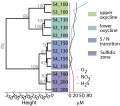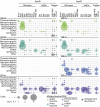Metaproteomics reveals differential modes of metabolic coupling among ubiquitous oxygen minimum zone microbes
- PMID: 25053816
- PMCID: PMC4128106
- DOI: 10.1073/pnas.1322132111
Metaproteomics reveals differential modes of metabolic coupling among ubiquitous oxygen minimum zone microbes
Abstract
Marine oxygen minimum zones (OMZs) are intrinsic water column features arising from respiratory oxygen demand during organic matter degradation in stratified waters. Currently OMZs are expanding due to global climate change with resulting feedback on marine ecosystem function. Here we use metaproteomics to chart spatial and temporal patterns of gene expression along defined redox gradients in a seasonally stratified fjord to better understand microbial community responses to OMZ expansion. The expression of metabolic pathway components for nitrification, anaerobic ammonium oxidation (anammox), denitrification, and inorganic carbon fixation were differentially expressed across the redoxcline and covaried with distribution patterns of ubiquitous OMZ microbes including Thaumarchaeota, Nitrospina, Nitrospira, Planctomycetes, and SUP05/ARCTIC96BD-19 Gammaproteobacteria. Nitrification and inorganic carbon fixation pathways affiliated with Thaumarchaeota dominated dysoxic waters, and denitrification, sulfur oxidation, and inorganic carbon fixation pathways affiliated with the SUP05 group of nitrate-reducing sulfur oxidizers dominated suboxic and anoxic waters. Nitrifier nitrite oxidation and anammox pathways affiliated with Nirospina, Nitrospira, and Planctomycetes, respectively, also exhibited redox partitioning between dysoxic and suboxic waters. The numerical abundance of SUP05 proteins mediating inorganic carbon fixation under anoxic conditions suggests that SUP05 will become increasingly important in global ocean carbon and nutrient cycling as OMZs expand.
Conflict of interest statement
The authors declare no conflict of interest.
Figures




References
-
- Paulmier A, Ruiz-Pino D. Oxygen minimum zones (OMZs) in the modern ocean. Prog Oceanogr. 2009;80(3-4):113–128.
-
- Wright JJ, Konwar KM, Hallam SJ. Microbial ecology of expanding oxygen minimum zones. Nat Rev Microbiol. 2012;10(6):381–394. - PubMed
-
- Whitney F, Freeland H, Robert M. Persistently declining oxygen levels in the interior waters of the eastern subarctic Pacific. Prog Oceanogr. 2007;75(2):179–199.
-
- Falkowski PG, et al. Ocean deoxygenation: Past, present, and future. Eos Trans AGU. 2011;92(46):409–410.
Publication types
MeSH terms
Substances
LinkOut - more resources
Full Text Sources
Other Literature Sources

